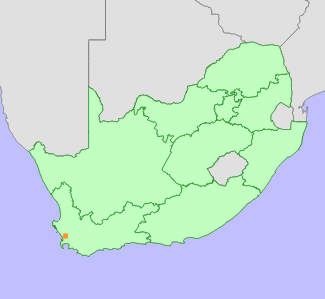|
Scientific Name | Marasmodes oligocephala DC. |
Higher Classification | Dicotyledons |
Family | ASTERACEAE |
Synonyms | Marasmodes polycephala DC. var. oligocephala (DC.) Harv. |
National Status |
Status and Criteria | Endangered B1ab(iii,v)+2ab(iii,v); C2a(i) |
Assessment Date | 2016/05/19 |
Assessor(s) | A.R. Magee, L. von Staden & D. Raimondo |
Justification | A small population of fewer than 500 mature individuals remain on four renosterveld remnants within a small area (EOO 7 km²). The largest subpopulation consists of about 200 mature individuals. This species continues to decline due to ongoing habitat degradation as well as competition from alien invasive plants. |
Distribution |
Endemism | South African endemic |
Provincial distribution | Western Cape |
Range | Atlantis to Malmesbury. |
Habitat and Ecology |
Major system | Terrestrial |
Major habitats | Swartland Shale Renosterveld, Swartland Silcrete Renosterveld, Atlantis Sand Fynbos |
Description | Silcrete outcrops in shale renosterveld. |
Threats |
| More than 90% of shale and silcrete renosterveld within this species' known range has been converted to crop fields, and only small remnants remain. These are densely infested with alien invasive plants, and continue to be degraded due to a lack of fire. Fire is required for regeneration of reseeding species such as Marasmodes oligocephala. In addition, livestock grazing is causing ongoing degradation of small fragments, especially when they are overstocked, as well as facilitating the spread of alien invasive grasses, which are particularly difficult to eradicate. |
Population |
Marasmodes oligocephala is a range-restricted and highly localized habitat specialist. Currently, four subpopulations remain on small renosterveld remnants within an area of 7 km². At two of these locations, the species is fairly common, with around 200 plants occurring at each. A third subpopulation is very small, consisting of about 10 plants. The fourth subpopulation was last observed in 2006, and the number of plants was not counted. This subpopulation occurs on a tiny fragment (2 ha), and is unlikely to be large. It is therefore estimated that the population numbers fewer than 500 mature individuals, and continues to decline due to ongoing habitat loss and degradation.
|
Population trend | Decreasing |
Notes |
| This species flowers in autumn and is very cryptic and can easily be missed during surveys for Environmental Impact Studies. |
Assessment History |
Taxon assessed |
Status and Criteria |
Citation/Red List version | | Marasmodes oligocephala DC. | EN B1ab(iii,v)+2ab(iii,v); C2a(i) | 2017.1 | | Marasmodes oligocephala DC. | CR B1ab(ii,iii,v)+2ab(ii,iii,v) | Raimondo et al. (2009) | | Marasmodes oligocephala DC. | VU D2 | Victor (2002) | | Marasmodes oligocephala DC. | Insufficiently Known | Hilton-Taylor (1996) | | Marasmodes oligocephala DC. | Uncertain | Hall et al. (1980) | |
Bibliography |
Goldblatt, P. and Manning, J.C. 2000. Cape Plants: A conspectus of the Cape Flora of South Africa. Strelitzia 9. National Botanical Institute, Cape Town.
Hall, A.V., De Winter, M., De Winter, B. and Van Oosterhout, S.A.M. 1980. Threatened plants of southern Africa. South African National Scienctific Programmes Report 45. CSIR, Pretoria.
Harvey, W.H. 1894. Compositae. In: W.H. Harvey and O.W. Sonder (eds). Flora Capensis III (Rubiaceae to Campanulaceae):44-530. L. Reeve & Co., Ltd., Ashford.
Hilton-Taylor, C. 1996. Red data list of southern African plants. Strelitzia 4. South African National Botanical Institute, Pretoria.
Hutchinson, J. 1916. Notes on African Compositae: II. Brachymeris, DC., and Marasmodes, DC. Bulletin of Miscellaneous Information (Royal Botanic Gardens, Kew) 1916(7):171-176.
Manning, J.C. and Goldblatt, P. 2012. Plants of the Greater Cape Floristic Region 1: The Core Cape Flora. Strelitzia 29. South African National Biodiversity Institute, Pretoria.
Raimondo, D., von Staden, L., Foden, W., Victor, J.E., Helme, N.A., Turner, R.C., Kamundi, D.A. and Manyama, P.A. 2009. Red List of South African Plants. Strelitzia 25. South African National Biodiversity Institute, Pretoria.
Victor, J.E. 2002. South Africa. In: J.S. Golding (ed), Southern African plant Red Data Lists. Southern African Botanical Diversity Network Report 14 (pp. 93-120), SABONET, Pretoria.
|
Citation |
| Magee, A.R., von Staden, L. & Raimondo, D. 2016. Marasmodes oligocephala DC. National Assessment: Red List of South African Plants version 2024.1. Accessed on 2025/12/04 |
 Comment on this assessment
Comment on this assessment


